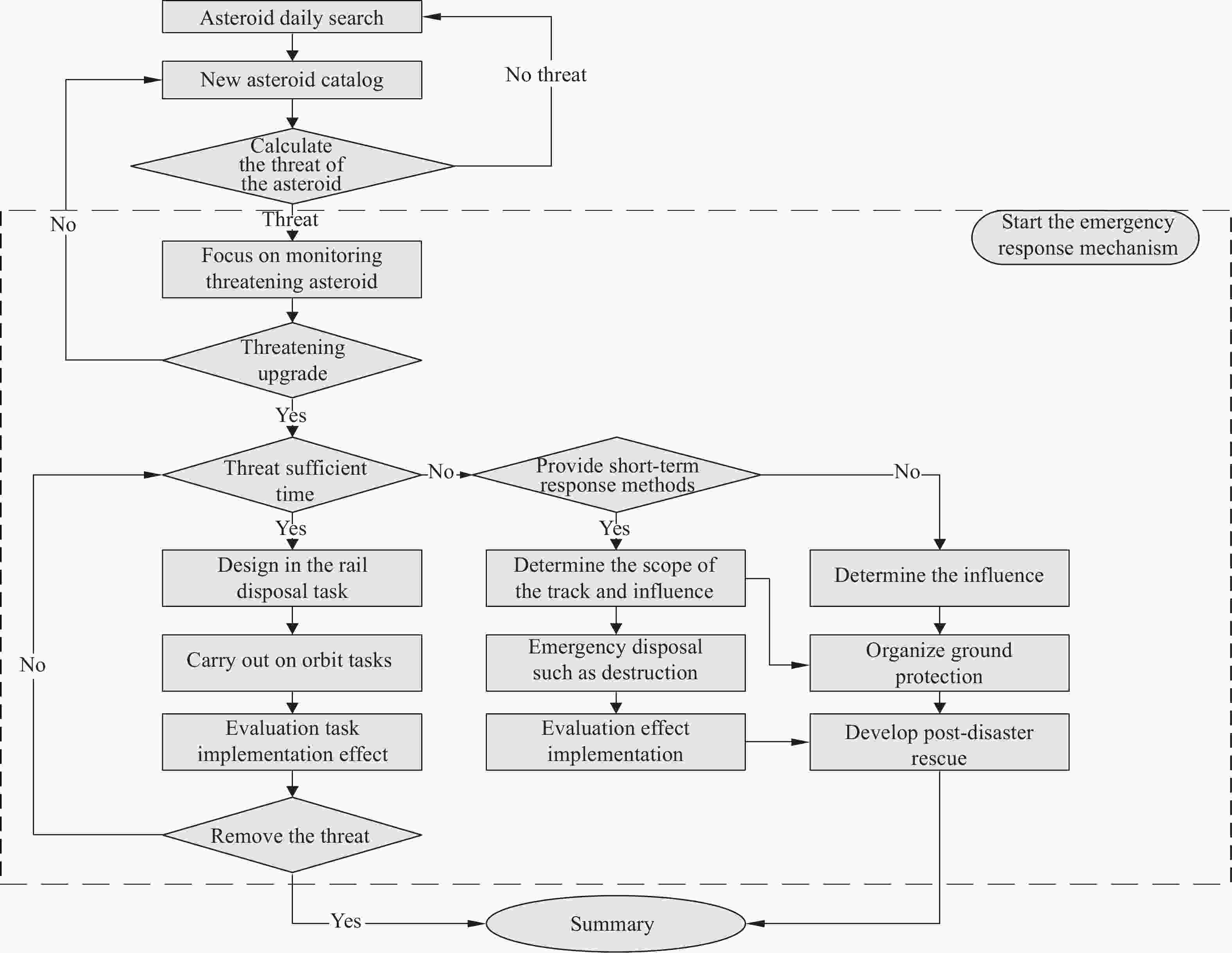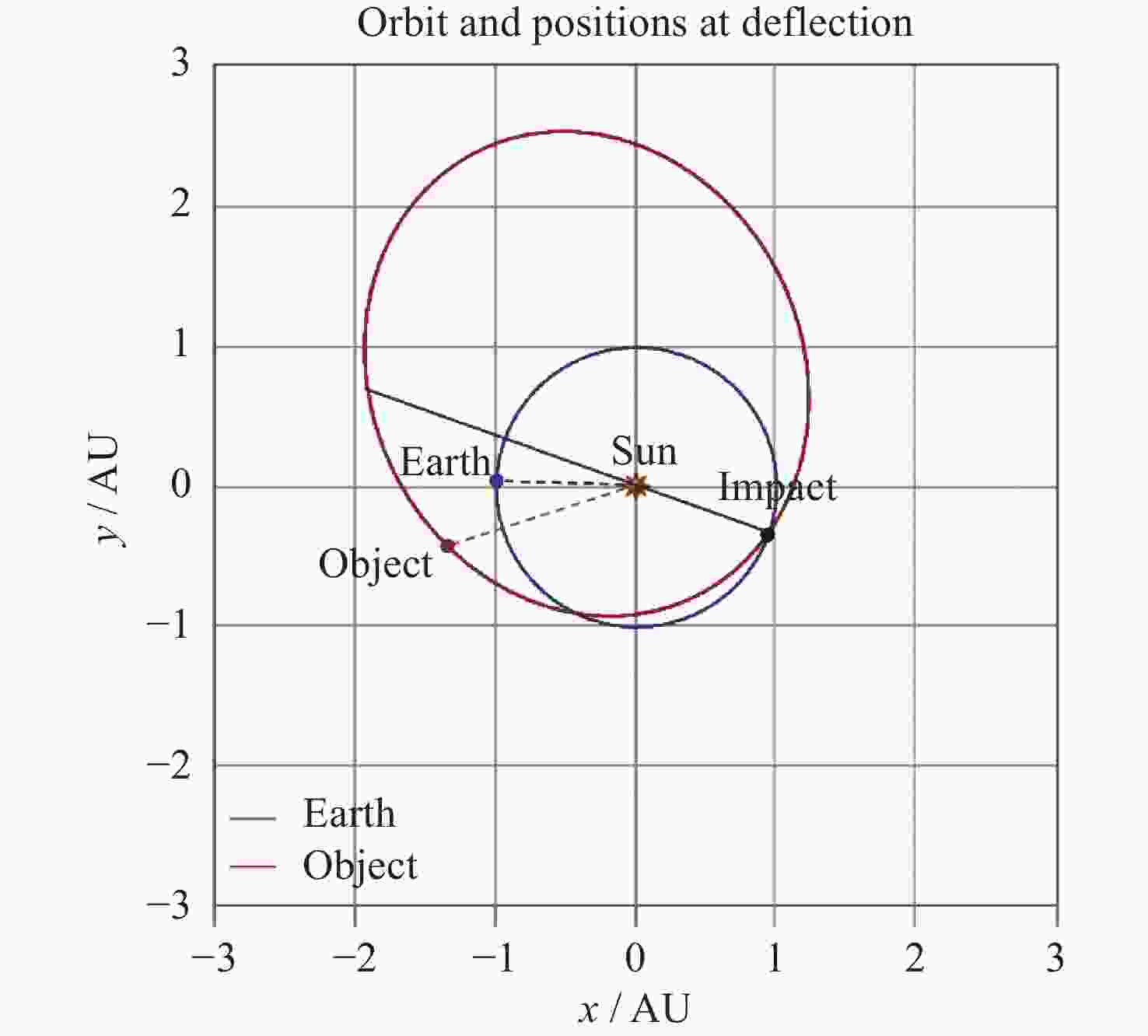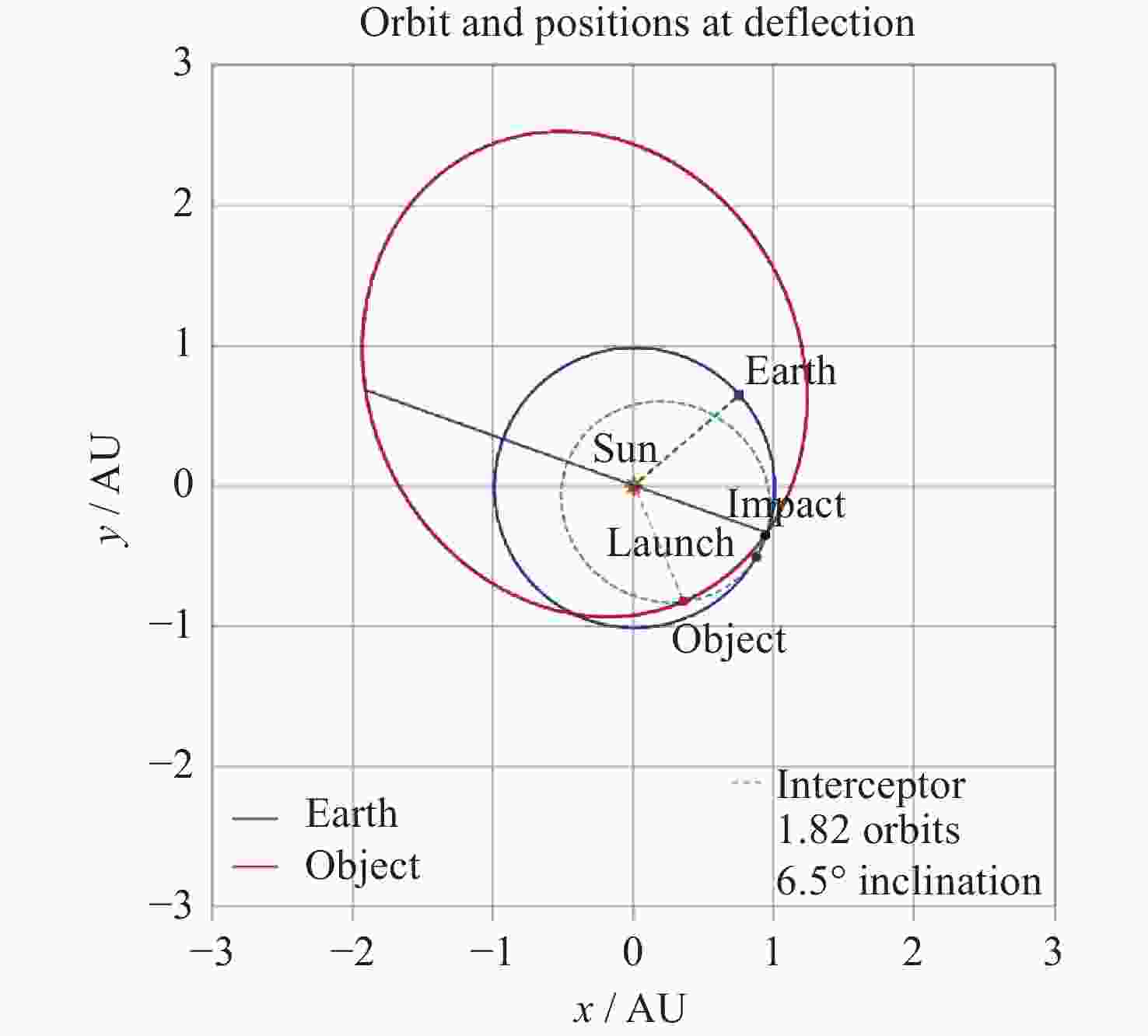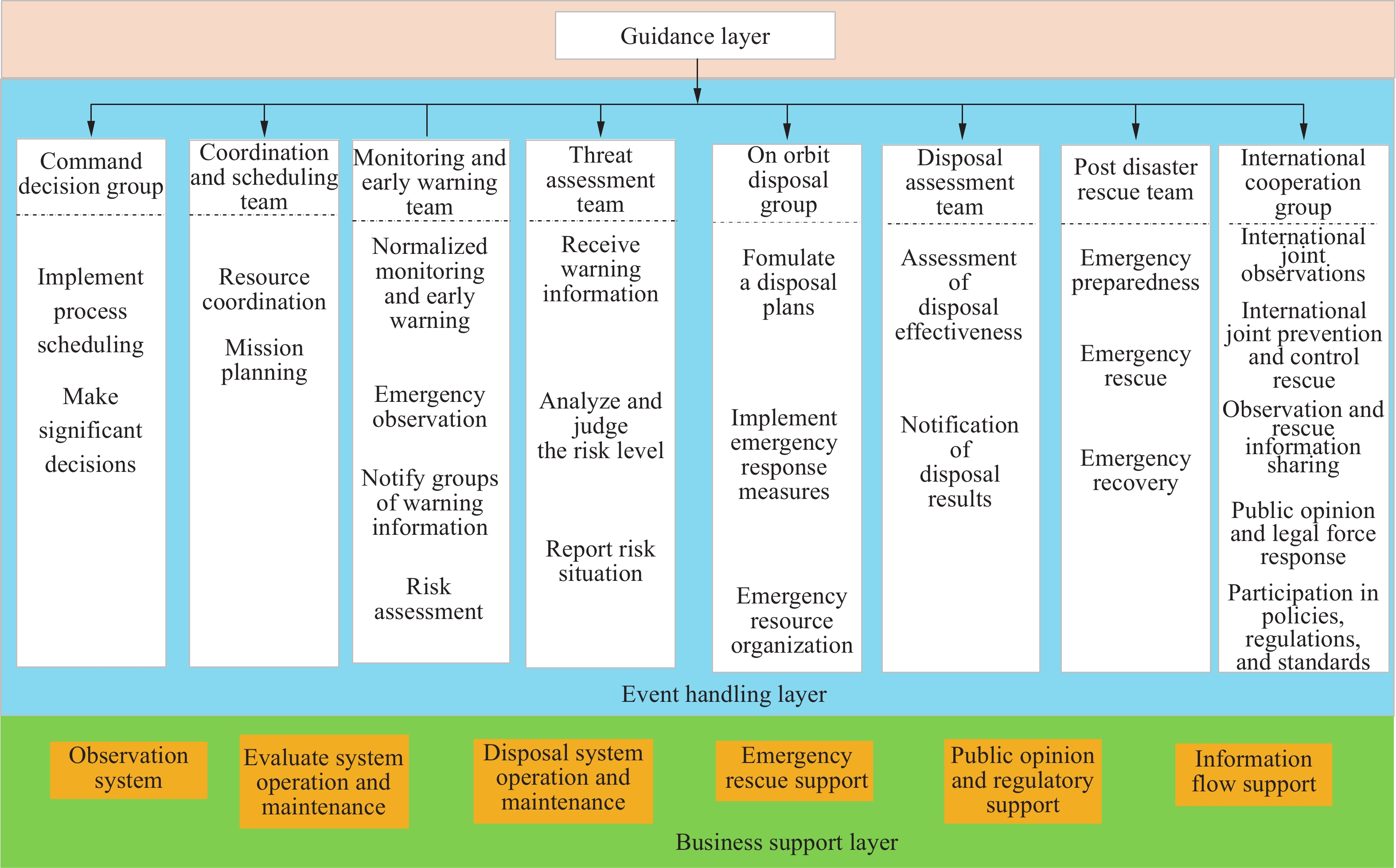Near-Earth Asteroid Impact Event Disposal Rules and Processes
-
摘要: 针对中国近地小行星防御研究在处置规则、协同机制、运行流程等方面存在的不足, 为了应对小行星防御和灾害救援方面不断提升的需求, 提出一种小行星防御仿真推演策略. 根据国内外小行星防御发展现状, 分析了中国小行星防御方面存在的差距. 从机制建立和协同应急处置的角度出发, 分析了国内外小行星防御仿真推演情况. 基于国内外研究现状, 设计了一套小行星防御仿真推演方案, 提出了中国开展小行星防御演练的组织架构, 包括指导层、事件处置层和业务支撑层等三个层次, 为小行星防御演练提供基本的组织支撑; 给出了小行星撞击事件的应急响应机制和一般处置规则设想, 为事件的处置和组织架构中各层次运行提供了规则基础; 初步设计了演练场景, 对机制和规则进行了验证, 为近地小行星防御工作组织及实施提供了参考.Abstract: In response to the shortcomings in the areas of disposal rules, coordination mechanisms, and operational procedures in China’s research on the defense of near-Earth asteroids, a simulation strategy for asteroid defense is proposed to meet the increasing demand for asteroid defense and disaster relief. Based on the current development status of asteroid defense at home and abroad, the gaps in China’s asteroid defense are analyzed. From the perspectives of mechanism establishment and coordinated emergency response, the simulation and deduction of asteroid defense at home and abroad are analyzed. Based on the current research status at home and abroad, a set of asteroid defense simulation and deduction plans are designed, and an organizational structure for China’s asteroid defense exercises is proposed, including three levels: guidance layer, event disposal layer, and business support layer, providing basic organizational support for asteroid defense exercises. The emergency response mechanism and general disposal rules for asteroid impact events are proposed, providing a rule basis for the disposal of events and the operation of each level in the organizational structure. The simulation scenarios are initially designed to verify the mechanisms and rules, providing a reference for the organization and implementation of near-Earth asteroid defense work.
-
表 1 小行星撞击所致危害
Table 1. Hazards caused by asteroid impacts
序号 等效直径/m 灾难等级 发生时间间隔/a 举例 1 >1000 全球性灾难 >700000 6500万年前的撞击事件 2 140~1000 洲际灾难 >30000 - 3 50~140 大城市级灾难 >2000 1908年俄罗斯通古斯事件 4 10~50 小城镇级灾难 >200 2013年车里雅宾斯克事件 5 <10 空爆和火流星 0.5 2023年法国2023 CX火流星事件 表 2 《近地物体撞击威胁紧急协议报告》行动基准
Table 2. Operational benchmarks for the emergency agreement on the threat of near-earth object impacts
基准 条件分类 具体条件 严密监视 威胁基准 SMPAG第一等级预警 时间基准 撞击发生前3年 在轨处置 威胁基准 50年内发生且概率大于10% 可行性基准 技术上可行且防御后撞击概率降低, 同时等待精密观测结果将降低防御成功率 危害基准 撞击造成美国100人以上伤亡, 或撞击损失大于防御成本 表 3 历次演练情况
Table 3. Overview of previous drills
演练 预警时间 主题 2013年TTX-1 1个月 增进联邦应急管理署对小行星撞击事件性质的了解, 并推演在侦测到小行星撞击事件后, 预警的演变过程 2014年TTX-2 7年 增进各参与机构对威胁小行星的性质和预警演变过程的了解; 分析灾害预警和响应程序的启动条件及使用策略 2016年TTX-3 4年 增进灾害响应部门对预警信息的特点、演变过程以及影响因素的了解 2022年TTX-4 6个月 增进参与部门对小行星防御过程的理解; 引导州政府和地方政府参与事后处置程序演练, 并对沟通机制开展测试 表 4 第 4次行星防御机构间桌面演练信息
Table 4. Information on the fourth inter-agency desktop exercise for planetary defense
项目 信息 推演日期 2022年2月23-24日 概述 由NASA行星防御协调办公室赞助, 多方参与开展一天半的桌面演练, 模拟小行星撞击美国大陆. 重点推演小行星撞击事件的事前预防、处置防护以及灾后救援等多个过程, 从预警、危害建模、在轨处置、灾害救援等多个方面检验和检测事件处置能力 推演构想 推演始于天文学家发现一颗小行星, 命名为2022 TTX, 可能在6个月后撞击地球. 同时随着推演的展开, 确认这颗小行星将撞击地球, 其大小足以对美国本土造成严重的区域破坏 参与机构
与职责NASA 行星防御协调办公室 演练过程管理, 以及与FEMA协调 近地天体研究中心 设计了小行星威胁情景; 为中小企业提供小行星探测、轨道确定和撞击概率等方面的信息 艾姆斯小行星威胁评估项目 模拟小行星撞击损害效应; 评估小行星撞击造成的损害 戈达德太空飞行中心 模拟太空任务的发射; 为专家组提供小行星减缓和侦察任务 应用物理实验室(约翰霍普金斯大学) 跨单位组织、主持和领导演练的规划、执行和文件编制; 为演练提供小行星、洲际弹道导弹(ICBM)缓解和法律/政策影响方面的专家 劳伦斯·利弗莫尔国家实验室 使用核爆炸装置(NED)模拟小行星
减缓州紧急行动中心 在州一级主持和领导执行 当地县第一反应社区 在地方一级领导规划和执行 场景设置 场景1 目标: 测试机构人员对天体撞击威胁和自身职责的理解; 测试各参与单位间信息沟通机制
时间: 发现目标后的12天至影响前约6个月
要素: NASA按照预案发布小新星撞击通知, 与此同时社交媒体上开始出现关于小行星撞击的错误信息. 分析解决方案以及使用核爆进行行星防御的国际法和条约考虑约束. NASA GSFC确认偏转方案不可行, 且发射飞跃探测器以及破坏装置的时间不足. 同时公布持续观测能力场景2 目标: 检验各参与机构早期的准备活动
时间: 撞击前2个月
要素: 社交媒体出现错误信息及应对; 小行星撞击威胁信息进一步明确, 但大小和材质仍然不确定, 威胁评估主要来自可能的地面撞击、爆炸冲击波以及热烧伤, 爆炸半径约160 km场景3 目标: 检验州一级的灾害应对准备
时间: 撞击前6天
要素: 确定受影响的县市范围; 小行星撞击危害信息基本明确, 受灾人口数十万, 建筑物和基础设施受到爆炸破坏场景4 目标: 撞击后的态势分析
时间: 撞击后几十小时
要素: 分析撞击对环境造成的影响, 同时协调灾害救援安保等表 5 各阶段阈值设置
Table 5. Threshold settings for each stage
处置 预警 条件 具体条件 日常编目 蓝色预警 基本条件 10年内撞击概率小于1% 危害条件 等效直径小于140 m 严密监视 黄色预警 基本条件 20年内发生且概率大于10% 危害条件 且等效直径大于30 m 在轨处置 红色预警 基本条件 50年内发生且概率大于10% 危害条件 直径大于30 m且撞击人口稠密区; 直径大于140 m且撞击东亚地区; 直径大于300 m且撞击地球任何地区 -
[1] YEOMANS D K. Near-Earth Objects: Finding Them Before They Find Us[M]. Princeton: Princeton University Press, 2013 [2] NASA. Near-Earth Object Survey and Deflection Analysis of Alternatives, Report to Congress[R]. NASA, 2007 [3] MA Pengbin, BAOYIN Hexi. Research status of the near-Earth asteroids’ hazard and mitigation[J]. Journal of Deep Space Exploration, 2016, 3(1): 10-17 [4] National Research Council (US). Defending Planet Earth: Near-Earth Object Surveys and Hazard Mitigation Strategies[M]. Washington: National Academies Press, 2010 [5] O’KEEFE J D, AHRENS T J. Impact production of CO2 by the Cretaceous/Tertiary extinction bolide and the resultant heating of the Earth[J]. Nature, 1989, 338(6212): 247-249 doi: 10.1038/338247a0 [6] BROWN P G, ASSINK J D, ASTIZ L, et al. A 500-kiloton airburst over Chelyabinsk and an enhanced hazard from small impactors[J]. Nature, 2013, 503(7475): 238-241 doi: 10.1038/nature12741 [7] MICHELI M, WAINSCOAT R J, DENNEAU L. Detectability of Chelyabinsk-like impactors with Pan-STARRS[J]. Icarus, 2018, 303: 265-272 doi: 10.1016/j.icarus.2017.10.010 [8] GONG Zizheng, LI Ming, CHEN Chuan, et al. The frontier science and key technologies of asteroid monitoring and early warning, security defense and resource utilization[J]. Chinese Science Bulletin, 2020, 65(5): 346-372 doi: 10.1360/TB-2019-0425 [9] KOSCHNY D, BUSCH M, DROLSHAGEN G. Asteroid observations at the Optical Ground Station in 2010—Lessons learnt[J]. Acta Astronautica, 2013, 90(1): 49-55 doi: 10.1016/j.actaastro.2012.10.002 [10] ZHANG Xiang, JI Jianghui. Ground-based radar detection of near-earth asteroids[J]. Progress in Astronomy, 2014, 32(1): 24-39 doi: 10.3969/j.issn.1000-8349.2014.01.02 [11] SONG Guangming, WU Qiang, CHEN Chuan, et al. Advances on mission analysis and design software for active planetary defense against near earth asteroids[J]. Space Debris Research, 2021, 21(2): 27-34 [12] NASA Glenn Research Center Space Science Projects Office. LTTT Suite Optimization Tools, in: A. Timothy Reckart (Ed. ), 23 April 2012[EB/OL]. http://microgravity.grc.nasa.gov/SSPO/ISPTProg/LTTT/, 2012-05 [13] General Mission Analysis Tool (GMAT). National Aeronautics and Space Administration Goddard Space Flight Center[EB/OL]. (2012-05). http://gmat.gsfc.nasa.gov/index.html [14] MELAMED N. Development of a handbook and an on-line tool on defending Earth against Potentially Hazardous Objects[J]. Acta Astronautica, 2013, 90(1): 165-172 doi: 10.1016/j.actaastro.2012.03.021 [15] VARDAXIS G, WIE B. Near-Earth object intercept trajectory design for planetary defense[J]. Acta Astronautica, 2014, 101: 1-15 doi: 10.1016/j.actaastro.2014.04.006 [16] VARDAXIS G, WIE B. Development of an asteroid mission design software tool for planetary defense[C]//3rd Planetary Defense Conference. Flagstaff, USA, 2013 [17] CANO J L, BELLEI G, MARTÍN J. NEO Threat mitigation software tools within the NEO shield project and application to 2015 PDC[C]//4th IAA Planetary Defense Conference-PDC 2015. Frascati, Roma, Italy, 2015 [18] CANO J L, BELLEI G, MARTÍN J. Integrated END-TO-END NEO threat mitigation software suite[C]//64th International Astronautical Congress. Beijing, China, 2013 [19] WANG Yuheng, SONG Rui, CHEN Linghui, et al. Research trends and reflections on international near-earth asteroid security defense[J]. Space Debris Research, 2018, 18(4): 1-10 [20] LI Honglin, DANG Lifang. Progress of U. S. -European joint near-earth asteroid defense mission[J]. Space Debris Research, 2021, 21(2): 35-39 [21] WU Weiren, GONG Zizheng, TANG Yuhua, et al. Response to risk of near-earth asteroid impact[J]. Strategic Study of CAE, 2022, 24(2): 140-151 [22] LI Haitao, LIU Jianjun, CHEN Shaowu, et al. Discussion on the requirements and feasibility of constructing China’s near-Earth asteroids radar system[J]. Scientia Sinica Informationis, 2021, 51(2): 325-346 doi: 10.1360/SSI-2020-0033 [23] MA Pinzhong. Design and research of space telescope[J]. Optics and Precision Engineering, 1994, 2(6): 67-74 [24] WANG Xintao, ZHENG Jianhua, LI Mingtao. Study on observation simulation for space-based potentially hazardous asteroids warning mission on Earth trailing heliocentric orbit[J]. Optics and Precision Engineering, 2020, 28(11): 2563-2571 doi: 10.37188/OPE.20202811.2563 [25] WANG Xintao, ZHENG Jianhua, LI Mingtao, et al. Warning of asteroids approaching Earth from the sunward direction using two Earth-leading heliocentric orbiting telescopes[J]. Icarus, 2022, 377: 114906 doi: 10.1016/j.icarus.2022.114906 [26] TANG Yuhua, WU Weiren, LI Mingtao, et al. Near-Earth asteroids observation system in cislunar space[J]. Scientia Sinica Informationis, 2022, 52(7): 1169-1185 doi: 10.1360/SSI-2022-0011 [27] SONG Guoming, CHEN Chun, GONG Zhizhong, et al. Experimental study on momentum coupling law of interaction between pulse laser and asteroid like material[C]//Dubai: The 71th International Astronautical Congress, 2021 [28] LI Mingtao, WANG Yirui, WANG Y L, et al. Enhanced kinetic impactor for defecting large potentially hazardous asteroids via maneuvering space rocks[J]. Scientific Reports, 2020(10): 1-15 [29] WANG Y R, LI M T, GONG Z Z, et al. Assembled kinetic impactor for deflecting asteroids by combining the spacecraft with the launch vehicle upper stage[J]. Icarus, 2021, 368: 114596 doi: 10.1016/j.icarus.2021.114596 [30] LI Yi, LIU Sen, CHEN Hong, et al. Application of NTS in near-Earth asteroid impact and defense[R]. Mianyang: First National Planetary Defense Symposium, 2018 [31] LUO Yue, WANG Lei, DANG Leining, et al. Arcjet ablation experiment to simulate the Chelyabinsk asteroid entry[J]. Chinese Journal of Theoretical and Applied Mechanics, 2020, 52(5): 1362-1370 [32] SUN Haihao, LUO Yue, DANG Leining, et al. The Melting Ablation Analysis of Meteorite in High Temperature Flow[R]. Internet: 7th Planetary Defense Conference, 2021 [33] GONG Hongming, CHANG Yu, LIAO Zhenyang, et al. Development and Test Capability of Ultra-High-Speed High Enthalpy Expansion Pipe Wind Tunnel[R]. Nanjing: 3rd National Planetary Defense Symposium, 2020 [34] LIU Sen, DANG Leining, ZHAO Junyao, et al. Hypervelocity issues of Earth impact by asteroids[J]. Chinese Journal of Theoretical and Applied Mechanics, 2018, 50(6): 1311-1327 [35] DANG Leining, LIU Sen, BAI Zhiyong, et al. Sensitivity research on models of Earth entry and impact effects by asteroids[J]. Chinese Journal of Theoretical and Applied Mechanics, 2021, 53(1): 278-292 [36] WANG Zonghao, DANG Leining, LIU Sen. Meteorite sonic boom research strategy and ballistic range test[J]. Space Debris Research, 2020, 20(3): 1-8 [37] GONG Jian, ZHANG Wei. Analysis on legitimacy of near-earth objects defense[J]. Space Debris Research, 2019, 19(3): 50-56 [38] Cneos[EB/OL]. (2015-01-01)[2020-04-20]. https://cneos.jpl.nasa.gov/pd/cs.html [39] Sensitivity to uncertainty in planetary defense risk assessment [EB/OL]. (2015-07-08) [2023-06-03]. https://ntrs.nasa.gov/api/citations/20160008942/downloads/20160008942.pdf [40] Asteroid Generated Tsunami: Summary of NASA/NOAA Workshop [EB/OL]. (2017-01-01) [2023-06-05]. https://ntrs.nasa.gov/api/citations/20170005214/downloads/20170005214.pdf [41] Tunguska Workshop: Applying Modern Tools to Understand the 1908 Tunguska Impact [EB/OL]. (2018-12-01) [2023-06-08]. https://ntrs.nasa.gov/api/citations/20190002302/downloads/20190002302.pdf [42] REDDY V, KELLEY M S, FARNOCCHIA D, et al. Near-Earth asteroid 2012 TC4 observing campaign: results from a global planetary defense exercise[J]. Icarus, 2019, 326: 133-150 doi: 10.1016/j.icarus.2019.02.018 [43] NASA/JPL NEO Deflection App[EB/OL]. [2023-06-08]. https://cneos.jpl.nasa.gov/nda/nda.html -
-





 洪宇:男, 1973年6月出生于陕西省渭南市. 现为宇航动力学国家重点实验室正高级工程师, 主要研究方向为航天测控工程、太空交通管理、外空政策法规等. E-mail:
洪宇:男, 1973年6月出生于陕西省渭南市. 现为宇航动力学国家重点实验室正高级工程师, 主要研究方向为航天测控工程、太空交通管理、外空政策法规等. E-mail:  陈永强:男, 1988年7月出生于甘肃省陇南市. 现为宇航动力学国家重点实验室工程师, 主要研究方向为太空交通管理. E-mail:
陈永强:男, 1988年7月出生于甘肃省陇南市. 现为宇航动力学国家重点实验室工程师, 主要研究方向为太空交通管理. E-mail: 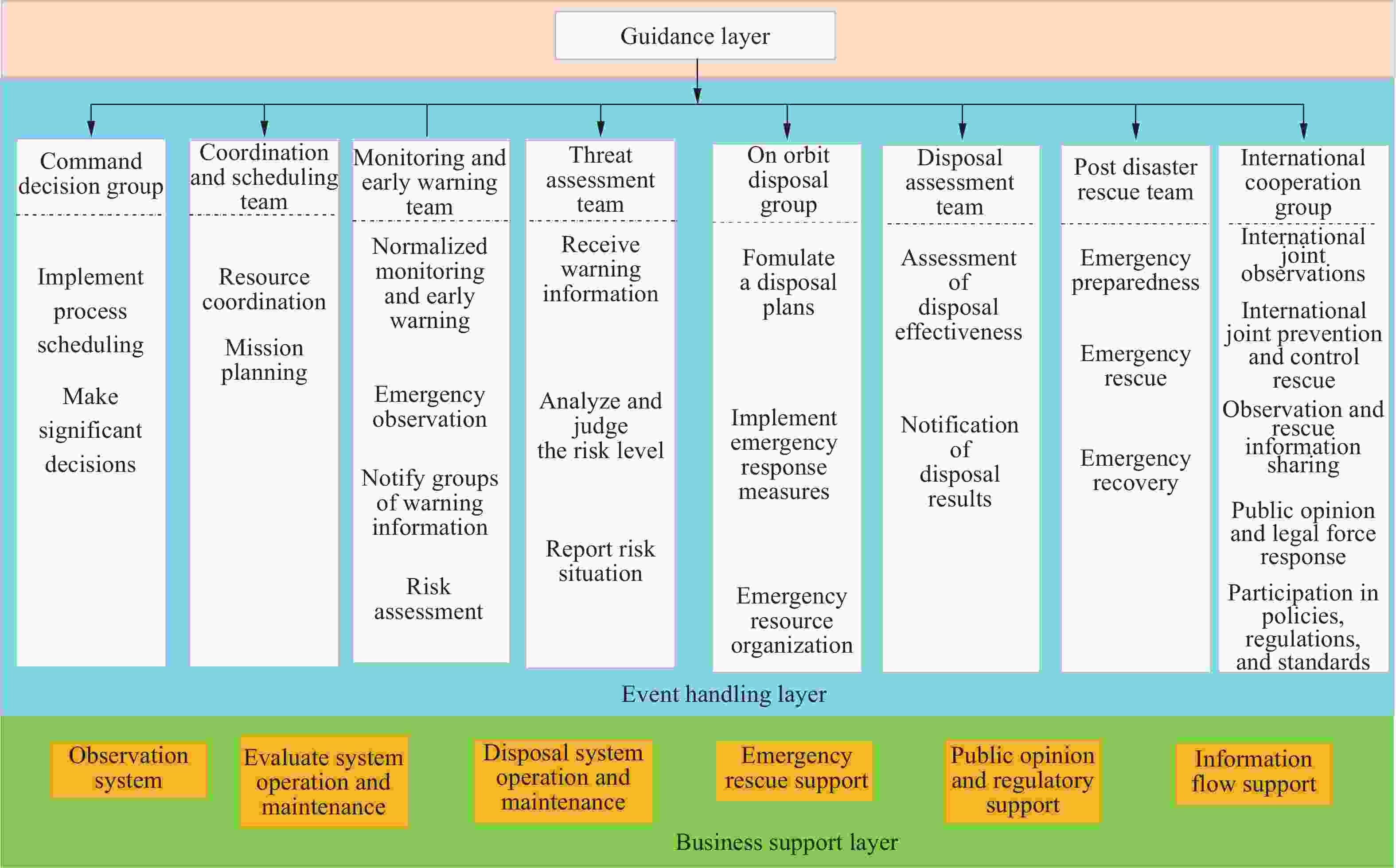
 下载:
下载:
